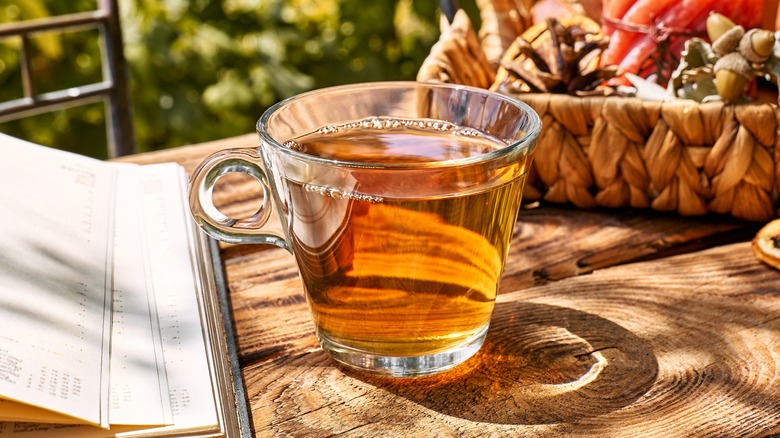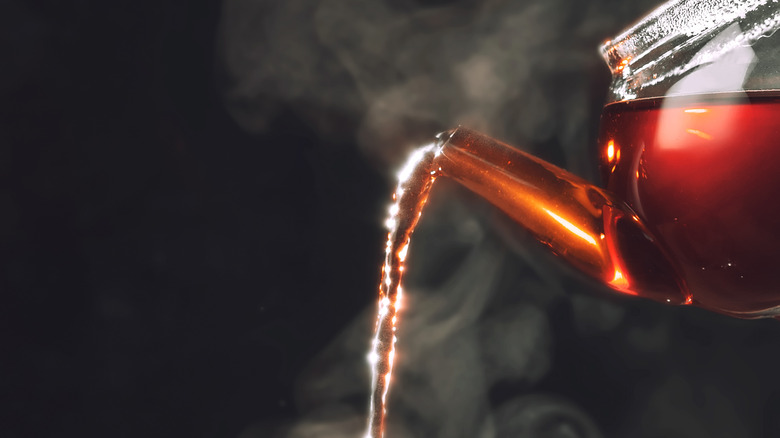Yaupon Is The Native North American Tea You Should Know
There's tea, and then there's sweet tea — if you understand the distinction, you were probably raised in the South. But, Southerners have been drinking tea well before Europeans thought to bring tea to North America. Native Americans brewed the leaves of a holly plant to make a caffeinated drink they called cassina, per Atlas Obscura.
Cassina, now known as yaupon tea, is North America's only native source of caffeine and contains about ⅓ of the amount as a cup of coffee. And, while more than 90% of Americans report consuming caffeine on a daily basis, it turns out that pouring yourself a cup of ambition truly is a Southern thing.
Since the global tea market was valued at 207.1 billion U.S. dollars in 2020, other than water, tea is the most consumed liquid worldwide, per National Geographic. Yet, the sordid history of inaccuracies caused yaupon's exclusion from such a vast market. "It's America's most important and neglected economic plant," Arkansas-based herbalist and author Steven Foster told Gravy. But, thanks to the mission of the American Yaupon Association (AYA) more than 10,000 pounds of yaupon are now distributed yearly, per BBC.
History of yaupon
Yaupon consumption in Native American tribes dates back to 1050 A.D. in the Cahokia Mounds in Southern Illinois, according to BBC. European travelers witnessed the tea ceremonies and documented them as early as the mid-16th through the late 17th century. Per their descriptions, the ceremonies involved fasting, vomiting, and cassina consumption. University of South Florida ethnobotanist and medical anthropologist Dr. Anna Dixon explained to BBC, "Before a big decision was made, yaupon would be consumed to purify people so that their decisions were clear."
Dubbed "black drink" by Spanish explorers, yaupon became known as "Carolina tea" and "South Sea tea" in England, and "appalachina" in France according to Atlas Obscura, noting the viability of the Linnaean classification system. The two-word Latin named species method prompted William Aiton, tasked by King George III, to give cassina its Linnaean name, Ilex vomitoria meaning "makes you vomit" even though it didn't — causing quite the stir.
Aiton never visited North America, so some believe the misnomer stemmed from sheer ignorance, while others believe it was to remedy the threat to the English tea trade.
"Yaupon is a sad symbol of erasure, and I hope that in trying to revive it we can offer a way to remind people of what's happened and create a little bit of correction," Bryon White of Yaupon Brothers American Tea Co. told BBC. Companies like Florida's Yaupon Brothers, North Carolina's Yaupon Tea Co., and Texas' Catspring Yaupon ship their teas. So, taste for yourself.
What it tastes like
Depending upon the length of roast, The Spruce Eats notes yaupon's mellow herbaceous profile, while Healthline echoes such subtleties. "Our original draw to yaupon tea was how much of a powerhouse this plant was with its unique natural sweetness and gentle energy from high-quality caffeine," Andrew Kiley of Yaupon Tea Co. explains to Star News.
Related to the South American yerba mate, yaupon's high concentrations of antioxidants, polyphenols, anti-inflammatory flavonoids, and theobromine can present a bittersweet nuance at times (via Yaupon America). "It tastes like green tea with more earthy maltiness," Scott Blackwell of High Wire Distilling told Gravy. The distillery is located in Charleston, South Carolina and uses yaupon in its Southern Amaro Liqueur.
When Alex Beggs of Bon Appétit stumbled upon Yaupon Brothers at the Fancy Food Show, she wrote, "I was entranced. It was refreshing and summery, and unlike anything I'd ever had before."
If you've never tasted yaupon tea, start by smelling it. Your sense of smell counts for 80% of the taste, per Science World. You may notice a strong nod to green beans on the nose, per Steepster. When tasting, Serious Eats suggests breathing out the finish where quality teas like yaupon are certain to linger. The rest is up to your personal palate.
How to brew it
"There is a lost art of preparing yaupon tea," yaupon researcher JennaDee Detro told NPR, "because there are so many years between the Native American use of yaupon tea and our modern use of yaupon tea."
After roasting the leaves, Native Americans would have brewed large batches over a fire. And, prior to serving the steaming hot elixer in large whelk seashell drinking vessels, they'd whip it into a froth much like today's cappuccino.
The modern process is much simpler and involves steeping the loose tea leaves or a tea bag, which is how 42% of Tasting Table readers like to make their tea. CatSpring Yaupon recommends 1 teaspoon of loose tea or one tea pouch per 14-ounce cup of water that you'll steep for 4 to 6 minutes, per Better Homes & Gardens. The key is to keep your water at 160ºF to 180ºF so you do not burn the leaves.
But, don't stop at one steep. Food Network refers to this first steep as the awakening steep, and that multiple steeps of high-quality tea will deepen its flavor. The second steep should last 5 to 8 minutes, then the times get subsequently longer, with the fourth steep clocking it at 9 to 12 minutes.
Although yaupon is considered a "lost art," it is certainly making a comeback, as the American Yaupon Association reports that more than two million cups of yaupon tea served to date.



